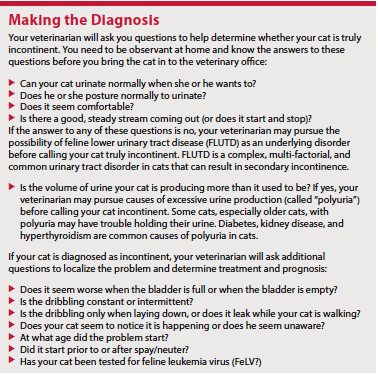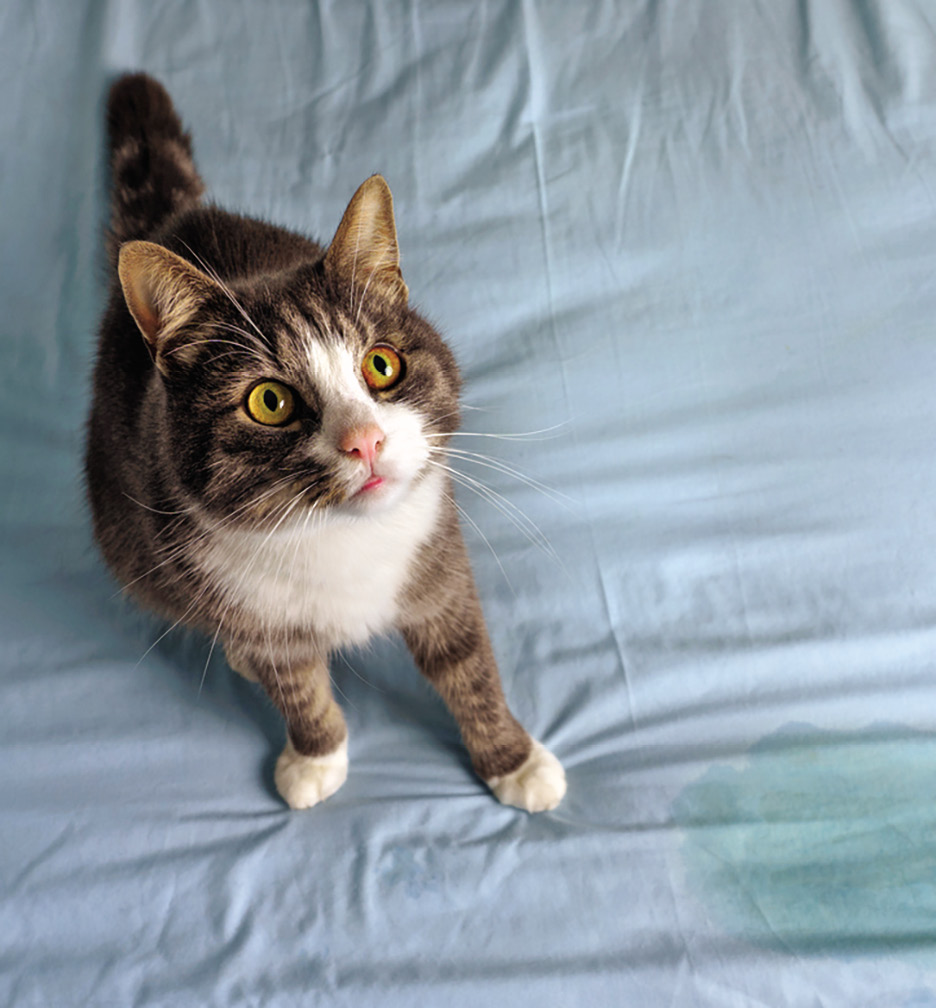Urinary incontinence is an involuntary leakage of urine. Most often, an incontinent cat is not aware that this leakage is happening. If you think your cat is experiencing this problem, it is extremely important that it is differentiated from inappropriate urination. With inappropriate urination, a cat voluntarily urinates in an undesirable manner or place. Your cat choosing to leave waste in an inappropriate spot is a common behavior problem, while urinary incontinence is relatively rare in cats.
“Urinary incontinence is not a common problem in cats,” says Dr. Suzanne Losito, Cornell Veterinary Class of 1988 and a practicing veterinarian at Fairmount Animal Hospital in Syracuse, N.Y. “This is a good thing, as these cases are often difficult to manage and devastating to the pet owner.”
To determine if the cause is incontinence, a cat acting out, or another disease, your veterinarian needs to see your cat.
Causes
The most common cause of urinary incontinence in cats is trauma to the pelvic area and tail, usually caused by getting hit by a car. Nerve damage to the lower spinal cord and/or peripheral nerves supplying the bladder can cause urinary incontinence.
A similar common trauma, called a “tail-pull” injury, happens when a car tire runs over the tail of a cat that is scampering across the road. The cat’s body keeps going, but the tail is trapped momentarily, resulting in separation of the nerves that run from the spinal cord to the pelvic area and tail.
The good news about tail-pull injuries is that some of these cats will regain urinary control over time, as the damaged nerves can regenerate. This healing can take many months, however, and it may be necessary for you to learn how to manually empty your cat’s bladder in the meantime.
If your cat has been incontinent since birth, a congenital defect is the most likely cause. These types of congenital defects are rare. A notable exception is Manx cats, who can suffer congenital urinary incontinence due to their unusual spinal conformation and associated neurologic deficits.
 Chronic, unresolved inflammation of the bladder (cystitis), whether due to FLUTD (see below), bacterial infection, or irritation from bladder stones, can result in urinary incontinence by causing abnormal thickening of the bladder wall. This thickening can either make the bladder muscle stiff, so it can’t relax normally to allow for bladder filling, or it can make the muscle irritable, resulting in overactive spasm, either of which can contribute to incontinence.
Chronic, unresolved inflammation of the bladder (cystitis), whether due to FLUTD (see below), bacterial infection, or irritation from bladder stones, can result in urinary incontinence by causing abnormal thickening of the bladder wall. This thickening can either make the bladder muscle stiff, so it can’t relax normally to allow for bladder filling, or it can make the muscle irritable, resulting in overactive spasm, either of which can contribute to incontinence.
Additional possible causes include ectopic ureters (a birth defect in which the tubes draining urine from the kidneys to the bladder attach in the wrong place in the urinary tract) and urethral hypoplasia (short or missing urethra).
Cats who have suffered a urinary obstruction that caused the bladder to become over-distended sometimes can end up with incontinence due to disruption of the muscle (called the “detrusor” muscle) fibers within the bladder wall. This is called “detrusor atony.” These cats may regain normal urinary function in a few weeks if the bladder is kept continually decompressed, which sometimes requires hospitalization and the placement of an indwelling, temporary urinary catheter.
Urethral sphincter mechanism incontinence is a common disorder in spayed female dogs in which the sphincter that normally holds the urine in the bladder until it is released no longer functions properly can happen in cats as well.
Spinal cord disease can cause urinary incontinence. Affected cats will typically have other symptoms like weakness or incoordination of the hind limbs and possibly fecal incontinence. While there are medications that may improve bladder function, unfortunately, many cats with urinary incontinence due to spinal cord disease don’t respond to therapy very favorably.
If your geriatric cat becomes incontinent, cancer may be the culprit. Tumors of the spinal cord can cause neurologic deficits that result in urinary incontinence. Tumors of the bladder and /or urethra can interfere with both filling and emptying of the bladder.
Feline leukemia virus (FeLV) has been linked to urinary incontinence. If you have an incontinent young cat, or an incontinent cat who goes outdoors, be sure to ask for an FeLV test.
Diagnostic testing for urinary incontinence usually includes physical exam (including neurologic and orthopedic exam), urinalysis, urine culture, abdominal and spinal x-rays, abdominal ultrasound, and bloodwork. Treatment and prognosis varies, depending on the diagnosis.
Some cases of feline urinary incontinence may be temporary and reversible. The incontinence may be secondary to something else, in which case correcting the underlying issue may resolve the problem.
Beyond that, however, the prognosis for return to normal function in many cases of feline urinary incontinence is guarded to poor.




